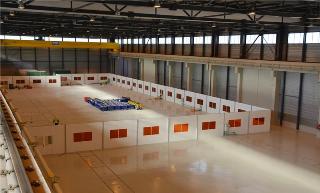Oct 29 2015
ITER is the biggest international collaboration in the field of energy aiming to demonstrate the feasibility of fusion power. The temperature of ITER’s superhot plasma is expected to reach 150 million ˚C and with the help of powerful superconducting magnets it will be confined.
 ITER Poloidal Field Coils Facility, F4E copyrigth
ITER Poloidal Field Coils Facility, F4E copyrigth
The first layer of magnets will consist of the Toroidal Field (TF) coils that will entrap the plasma and keep it away from the walls of the vacuum vessel. The second layer will consist of the Poloidal Field (PF) coils that will embrace the TF coils from top to bottom to maintain the plasma’s shape and stability. Due to their impressive diameter and weight, four out of the six PF coils will be manufactured in a facility located on the ITER site.
F4E, the EU organisation managing Europe’s contribution to ITER, has signed a contract with a consortium formed by Dalkia, part of the EDF Group which is one of the world’s leading electric utilities, together with Veolia, through its subsidiaries Propreté Industries Services (VPIS) and the Water activity of Veolia in France, for the infrastructure supply, operation, maintenance and waste management of ITER’s PF coils building.
The contract will run for at least five years and has a value of approximately 12 million EUR. F4E acting Director, Pietro Barabaschi explained that “through the signature of this contract the first engineering hub on the ITER site will be equipped to manufacture some of the most impressive superconducting magnets used for a fusion device”. Jean-Michel Mazalérat, Chairman and CEO of Dalkia, stated: “Thanks to this contract Dalkia has the opportunity to bring its energy services expertise to the table and contribute to a major international energy project. Together with Veolia we count ourselves among the most committed and ambitious contractors of the ITER project. We are proud to cooperate on this project and we are sure of its success”.
The ITER Poloidal Field coils facility
The construction of the PF coils building has been financed by F4E through a contract signed with the consortium of Spie batignolles, Omega Concept and Setec. The building is approximately 250 metres long, 45 metres wide and 17 metres high. It includes regular services (HVAC, electrical, piping), two large cranes (one standard crane with a capacity of 25 tonnes and another crane especially adapted with a capacity of 40 tonnes), offices, technical rooms and workshop space. Parking and two docking areas for the unloading and temporary placement of coils are also envisaged. The building offers adequate space to carry out all the steps of coil manufacturing: winding, impregnation, stacking and cold testing. It has the capacity to host maximum 80 people at the same time.
The scope of the contract
Now that the Dalkia-Veolia consortium has taken the PF coils building under its responsibility, it will furnish the building with the appropriate infrastructure: clean areas, additional workshop rooms, electrical and other utility distribution systems as well as the construction of an external building where superconductor spools will be stored in. Furthermore, the contractor will have to maintain and operate the infrastructure, train manufacturers and suppliers’ personnel to operate the two cranes, supervise loading and unloading operations, offer surveillance and be in charge of waste management.
How will the ITER Poloidal Field Coils be manufactured?
Europe is responsible for five out of the six PF coils. Four of them will be manufactured in this facility. The fifth coil is being manufactured through a collaboration agreement between F4E and the ASIPP laboratory in Hefei, China. All five coils will be cold tested in the facility while the sixth coil, manufactured by Russia, is expected to be delivered directly to the ITER machine.
Once the 1 100 tonnes of the stainless steel clad niobium titanium conductor arrive on the ITER site, in order to manufacture the European coils, they will progressively move from the external storage area to the manufacturing hub, where the winding and vacuum impregnation processes will be carried out. During the moulding stage, epoxy resin will be uniformly applied to help the layers of the conductor to bond tightly in order to create a coil known as double pancake. Then, a second impregnation process will take place to bond the stack of the double pancakes to form one complete massive coil. The diameter of the largest PF coil is around 25 metres and their weights range between 200 and 400 tonnes.
Source: http://fusionforenergy.europa.eu/